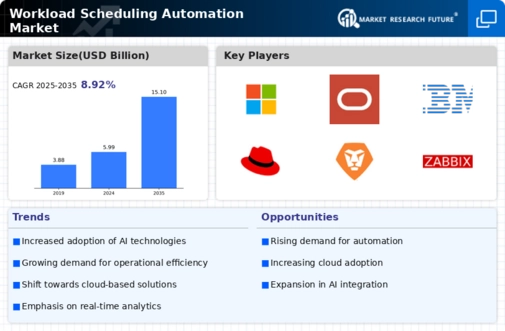The Workload Scheduling Automation Market is currently characterized by a dynamic competitive landscape, driven by the increasing demand for operational efficiency and the integration of advanced technologies. Major players such as IBM (US), Microsoft (US), and Oracle (US) are strategically positioned to leverage their technological prowess and extensive resources. IBM (US) focuses on innovation through its AI-driven solutions, while Microsoft (US) emphasizes cloud-based offerings that enhance scalability and flexibility. Oracle (US) is known for its robust enterprise resource planning systems, which integrate workload scheduling seamlessly into broader business processes. Collectively, these strategies foster a competitive environment that prioritizes technological advancement and customer-centric solutions.
In terms of business tactics, companies are increasingly localizing their operations and optimizing supply chains to enhance responsiveness to market demands. The competitive structure of the workload scheduling automation market appears moderately fragmented, with a mix of established players and emerging startups. This fragmentation allows for diverse offerings, yet the influence of key players remains substantial, as they set benchmarks for innovation and service quality.
In August 2025, IBM (US) announced the launch of its new AI-powered workload automation platform, which aims to streamline operations across various industries. This strategic move is significant as it not only enhances IBM's product portfolio but also positions the company as a leader in integrating AI into workload management, potentially attracting a broader customer base seeking advanced automation solutions. The emphasis on AI reflects a growing trend in the market towards intelligent automation, which could redefine operational efficiencies.
In September 2025, Microsoft (US) expanded its Azure cloud services to include enhanced workload scheduling capabilities, targeting enterprises looking for integrated solutions. This expansion is crucial as it aligns with the increasing shift towards cloud-based infrastructures, allowing businesses to manage workloads more effectively while benefiting from the scalability of cloud technology. By enhancing its Azure offerings, Microsoft (US) strengthens its competitive edge in the market, appealing to organizations prioritizing digital transformation.
In July 2025, Oracle (US) entered a strategic partnership with a leading logistics firm to develop tailored workload scheduling solutions for supply chain management. This collaboration is indicative of Oracle's commitment to industry-specific solutions, which may enhance its market penetration and customer loyalty. By focusing on niche markets, Oracle (US) could potentially differentiate itself from competitors, thereby solidifying its position in the workload scheduling automation landscape.
As of October 2025, the competitive trends in the workload scheduling automation market are increasingly defined by digitalization, sustainability, and the integration of artificial intelligence. Strategic alliances among key players are shaping the landscape, fostering innovation and collaborative solutions. Looking ahead, it appears that competitive differentiation will evolve from traditional price-based competition to a focus on innovation, technological advancements, and supply chain reliability. Companies that can effectively harness these trends are likely to emerge as leaders in this rapidly evolving market.


















Leave a Comment